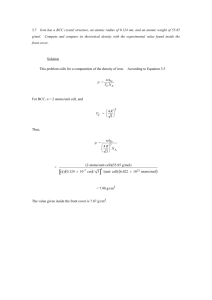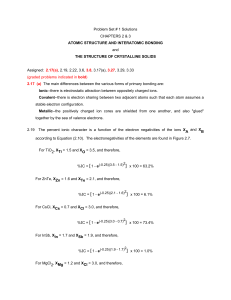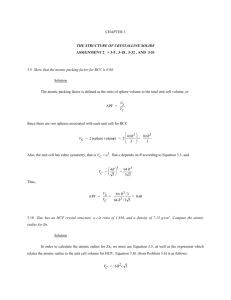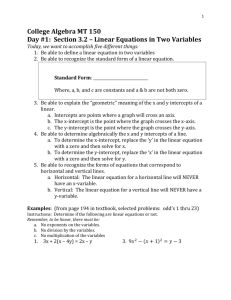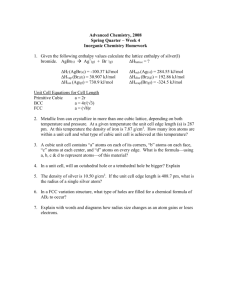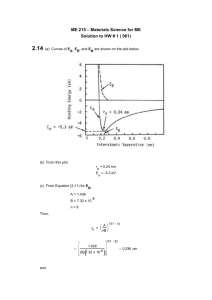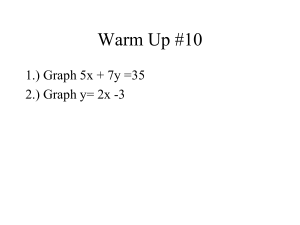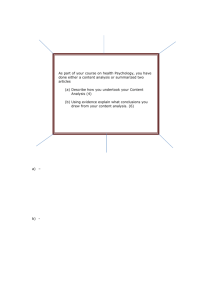CHAPTER 3
advertisement
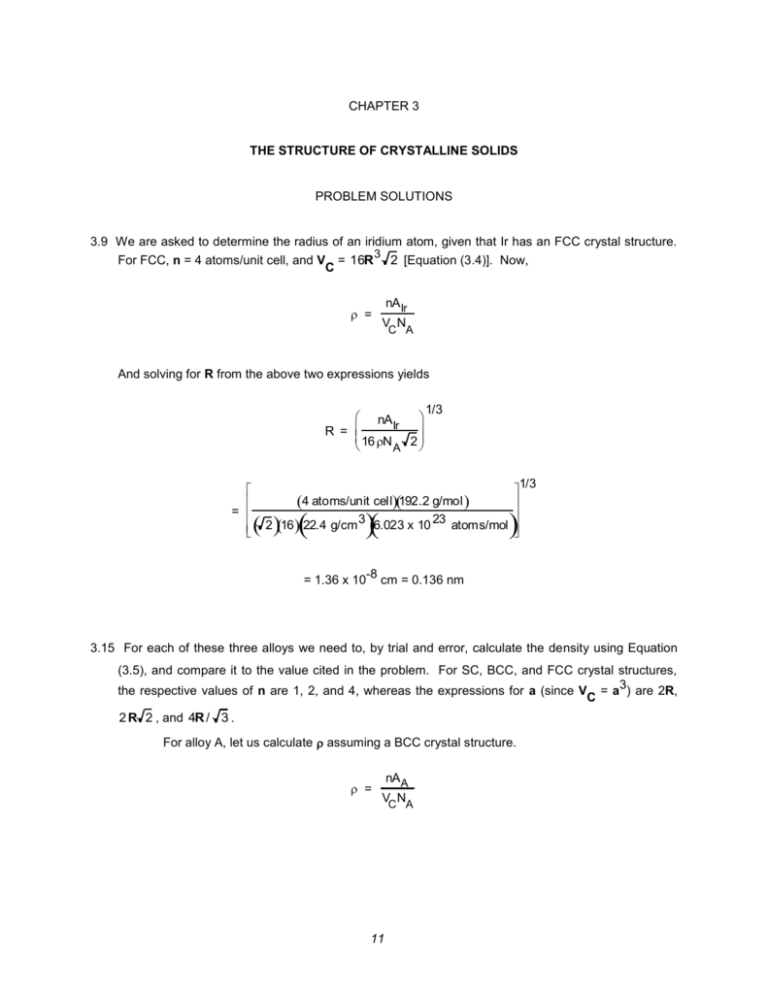
CHAPTER 3 THE STRUCTURE OF CRYSTALLINE SOLIDS PROBLEM SOLUTIONS 3.9 We are asked to determine the radius of an iridium atom, given that Ir has an FCC crystal structure. For FCC, n = 4 atoms/unit cell, and V = 16R 3 2 [Equation (3.4)]. Now, C = nA Ir VC NA And solving for R from the above two expressions yields 1/3 nA Ir R = 16 N 2 A 4 atoms/unit cell192.2 g/mol = 3 23 2 16 22.4 g/cm 6.023 x 10 atoms/mol = 1.36 x 10 -8 1/3 cm = 0.136 nm 3.15 For each of these three alloys we need to, by trial and error, calculate the density using Equation (3.5), and compare it to the value cited in the problem. For SC, BCC, and FCC crystal structures, 3 the respective values of n are 1, 2, and 4, whereas the expressions for a (since V = a ) are 2R, C 2 R 2 , and 4R / 3 . For alloy A, let us calculate assuming a BCC crystal structure. = nA A VC NA 11 = (2 atoms/unit cell)(43.1 g/mol) 3 -8 (4) 1.22 x 10 cm /(unit cell) 6.023 x 10 23 atoms/mol 3 = 6.40 g/cm 3 Therefore, its crystal structure is BCC. For alloy B, let us calculate assuming a simple cubic crystal structure. = (1 atom/unit cell)(184.4 g/mol) 3 2 1.46 x 10 -8 cm /(unit cell) 6.023 x 10 23 atoms/mol = 12.3 g/cm 3 Therefore, its crystal structure is simple cubic. For alloy C, let us calculate assuming a BCC crystal structure. = (2 atoms/unit cell)(91.6 g/mol) 3 -8 (4) 1.37 x 10 cm 23 atoms/mol /(unit cell) 6.023 x 10 3 = 9.60 g/cm 3 Therefore, its crystal structure is BCC. 3.21 (a) The unit cell shown in the problem belongs to the tetragonal crystal system since a = b = 0.35 nm, c = 0.45 nm, and = = = 90. (b) The crystal structure would be called body-centered tetragonal. (c) As with BCC, n = 2 atoms/unit cell. Also, for this unit cell 4.5 x 108 cm VC = 3.5 x 10 8 cm 12 2 = 5.51 x 1023 cm3/unit cell Thus, = nA V N C A = 2 atoms/unit cell141 g/mol -23 5.51 x 10 cm3 /unit cell 6.023 x 1023 atoms/mol = 8.50 g/cm 3.27 A tetragonal unit in which are shown the 11 1 2 and 3 111 2 42 point coordinates is presented below. 3.28 This portion of the problem calls for us to draw a [12 1 ] direction within an orthorhombic unit cell (a ≠ b ≠ c, = = = 90). Such a unit cell with its origin positioned at point O is shown below. We first move along the +x-axis a units (from point O to point A), then parallel to the +y-axis 2b units (from point A to point B). Finally, we proceed parallel to the z-axis -c units (from point B to point C). The [12 1 ] direction is the vector from the origin (point O) to point C as shown. 13 We are now asked to draw a (210) plane within an orthorhombic unit cell. First remove the three indices from the parentheses, and take their reciprocals--i.e., 1/2, 1, and . This means that the plane intercepts the x-axis at a/2, the y-axis at b, and parallels the z-axis. The plane that satisfies these requirements has been drawn within the orthorhombic unit cell below. 3.30 (a) We are asked for the indices of the two directions sketched in the figure. For direction 1, the projection on the x-axis is zero (since it lies in the y-z plane), while projections on the y- and z-axes are b/2 and c, respectively. This is an [012] direction as indicated in the summary below 14 Projections x y z 0a b/2 c 0 1/2 1 0 1 2 Projections in terms of a, b, and c Reduction to integers [012] Enclosure Direction 2 is [11 2] as summarized below. Projections x y z a/2 b/2 -c 1/2 1/2 -1 1 1 -2 Projections in terms of a, b, and c Reduction to integers [11 2] Enclosure (b) This part of the problem calls for the indices of the two planes which are drawn in the sketch. Plane 1 is an (020) plane. The determination of its indices is summarized below. x y z a b/2 c Intercepts in terms of a, b, and c 1/2 Reciprocals of intercepts 0 2 0 Intercepts (020) Enclosure Plane 2 is a (22 1) plane, as summarized below. x y z Intercepts a/2 -b/2 c Intercepts in terms of a, b, and c 1/2 -1/2 1 2 -2 1 Reciprocals of intercepts 15 (22 1) Enclosure 3.33 Direction A is a [33 1 ] direction, which determination is summarized as follows. We first of all position the origin of the coordinate system at the tail of the direction vector; then in terms of this new coordinate system x y a b - and c 1 1 - Reduction to integers 3 3 Projections z c 3 Projections in terms of a, b, 1 3 -1 [33 1 ] Enclosure Direction B is a [4 03 ] direction, which determination is summarized as follows. We first of all position the origin of the coordinate system at the tail of the direction vector; then in terms of this new coordinate system x Projections y 2a - 3 z c 0b - 0 - 0 -3 2 Projections in terms of a, b, and c Reduction to integers - 2 3 -4 1 2 [4 03 ] Enclosure Direction C is a [361] direction, which determination is summarized as follows. We first of all position the origin of the coordinate system at the tail of the direction vector; then in terms of this new coordinate system x Projections - y a b 2 z c 6 Projections in terms of a, b, and c Reduction to integers - 1 1 2 -3 6 16 1 6 1 [361] Enclosure Direction D is a [ 1 1 1 ] direction, which determination is summarized as follows. We first of all position the origin of the coordinate system at the tail of the direction vector; then in terms of this new coordinate system Projections x y a b 2 2 1 1 2 2 -1 1 - z - c 2 Projections in terms of a, b, and c Reduction to integers - - 1 2 -1 [111] Enclosure 3.36 For plane A we will leave the origin at the unit cell as shown. If we extend this plane back into the plane of the page, then it is a (11 1 ) plane, as summarized below. Intercepts x y z a b -c 1 1 -1 1 1 -1 Intercepts in terms of a, b, and c Reciprocals of intercepts Reduction not necessary Enclosure (11 1 ) For plane B we will leave the origin of the unit cell as shown; this is a (230) plane, as summarized below. Intercepts x y a b 2 3 1 1 2 3 2 3 z ∞c Intercepts in terms of a, b, and c Reciprocals of intercepts Enclosure (230) 17 ∞ 0
